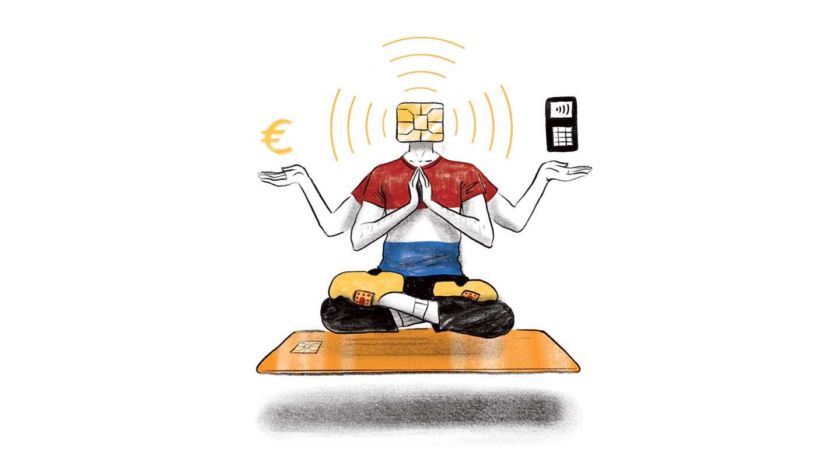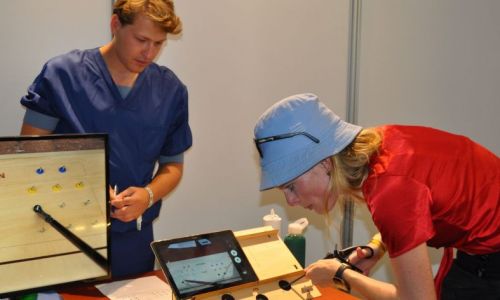The five stages of Dutch money culture
-
 Illustratie: Roel Venderbosch
Illustratie: Roel Venderbosch
For the Dutch, paying by card is the most natural thing in the world. Even a coffee in the Refter you pay with your bank card. But our culture of paying (contactless) can drive internationals mad. The German student Antonia Leise describes in five steps how foreign students can master the Dutch money habits.
When I moved to the Netherlands in 2016, I had many expectations about the differences between the Dutch and my own German culture. Many things were to be discovered — from bicycle-highways to the concept of ’gezelligheid.’ And three years later, many things continue to remain a mystery — mainly, the exact content of bitterballen.
The most striking anthropological experience for me so far was, however, not related to any obvious cultural difference. It was, plain and simple, the entirety of Dutch money culture. Now, after more than three years of careful observation, I have managed to draw up the five stages of the pathway of ultimately mastering the money habits of the Dutch.
1. No cash, card only
Only paying by card is the most obvious part of Dutch money culture and the first step to become a citizen at heart. The Netherlands is the most card-friendly (and most cash-unfriendly) nation I have ever visited. There are most certainly countries that would put the Dutch’s debit card usage to shame, but compared to my experience growing up in Germany, it has been quite the culture shock.
Where I come from, it is completely impossible to use your card to pay for anything under at least five euros. There may be a very hip ice cream shop in Berlin where you can buy your vegan chocolate/matcha/cherry ice cream with Bitcoins, but even the most hipster places in Germany’s most hipster city would accept cash money. In Nijmegen, cash will even bring you trouble when you are buying a simple coffee on campus.
2. Paying contactless
This next thing is something I will continue to marvel at throughout the next decade. Paying by only holding your card against a machine is, however, something seemingly second nature to my Dutch friends and acquaintances. My German bank and I have been trying to figure out my debit card’s contactless-function ever since I moved to Nijmegen and after three years, I have given up all hope that we ever will.
My German debit card’s inability of contactless payment is also partially responsible for my recent opening of a Dutch bank account. It was the only way to get the fancy syrup-flavored coffee from the vending machines at the library. I’m only human.
3. iDEAL
Since I first moved here, every time iDEAL pops up as the payment option, I immediately break into cold sweat. It has been the content of my nightmares and the reason for a lot of screaming at computer screens while trying to order something online.
Mind you, iDEAL is a great tool for money transfer, I will give it that. However, not being able to open it with a non-Dutch bank account is really annoying. I am not sure if Dutch people notice how integrated iDEAL is in their payments and how difficult it can be to not have it. If there is a metaphorical border that distinguishes Dutch money culture from that of other countries, this is where I would say it is.
4. Tikkie
Once iDEAL has been integrated into your life, you’re practically already Dutch. But it is by far not the end of it. If you truly want to reach native level of online payment, you will have to mingle with the apps, of which Tikkie is one of the most well-known.
I have probably never looked more confused than when I was told that you can do payments via WhatsApp. In fact, if you read the last sentence out loud and listen very carefully, I am pretty sure you can hear a German bank employee suffering a stroke. I once tried to increase my credit card limit on the phone with my hometown bank where I have been a customer for more than ten years, and was told that I would have to physically travel to Germany and do that in person. Talking about differences.
5. WieBetaaltWat
It is only when you start using WieBetaaltWat that you can reach the ultimate level of Dutch-ness. It is, by definition, the ultimate way to ‘go Dutch’. This app includes every aspect of Dutch money culture. It is precise, yet simple, and, most of all, it abandons the concept of cash entirely.
While you can observe confused cash-exchanges at restaurant tables after a group-dinner in virtually every European country, the Dutch have an app for that. And an evidently well-working one. Obviously.
It is only when you have reached this level of functioning online payment that you will understand that it is not legal weed or constant biking what makes Dutch people so chill. It is their mastery of bureaucracy and their ability to do almost every aspect of it online.



